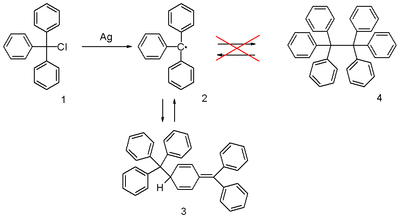Triphenylmethyl radical

| |

| |
| Names | |
|---|---|
| Preferred IUPAC name
Triphenylmethyl | |
| Identifiers | |
3D model (
JSmol ) |
|
| ChemSpider | |
PubChem CID
|
|
| |
| |
| Properties | |
| C19H15 | |
| Molar mass | 243.329 g·mol−1 |
Except where otherwise noted, data are given for materials in their standard state (at 25 °C [77 °F], 100 kPa).
| |
The triphenylmethyl radical (often shorted to trityl radical) is an
Preparation and properties
It can be prepared by

Solutions containing the radical are yellow; when the temperature of the solution is raised, the yellow color becomes more intense as the equilibrium is shifted in favor of the radical (in accordance with Le Chatelier's principle).
When exposed to air, the radical rapidly oxidizes to the peroxide, and the color of the solution changes from yellow to colorless. Likewise, the radical reacts with iodine to triphenylmethyl iodide.
History
The radical was discovered by Moses Gomberg in 1900 at the University of Michigan.[6][7][8] He tried to prepare hexaphenylethane from triphenylmethyl chloride and zinc in benzene in a Wurtz reaction and found that the product, based on its behaviour towards iodine and oxygen, was far more reactive than anticipated. The discovered structure was used in the development of ESR spectroscopy and confirmed by it.[9][10][11]
The correct
See also
References
- ISBN 9780470666975.
- ISBN 978-0-471-72091-1
- Bibcode:2008moma.book.....L
- PMID 22025456.
- PMID 25704856.
- .
- . (Note: radical is also called a cadicle.)
- .
- .
- .
- ^ "ESR spectrum of the triphenylmethyl radical". School of Chemistry, University of Bristol. Retrieved August 5, 2018.
- .
- .
